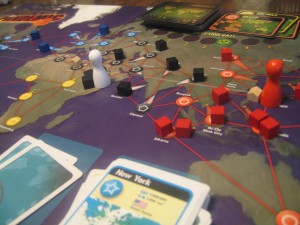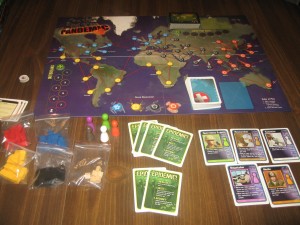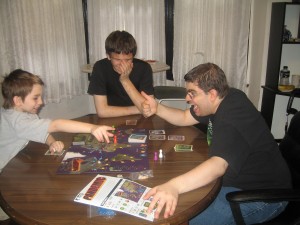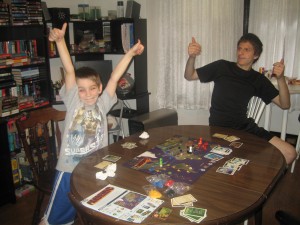Saving the world, it turns out, is pretty frickin difficult…at least it is in the board game I’m about to review. I’ve hyped about it in other articles and am finally getting around to writing about it. Let’s take a quick look and see what Pandemic is all about.
*Note: The box says two to four players, other sources say two to five players. There are five role cards and five player tokens so I don’t see why five people couldn’t play…though it would be quite a challenge. The infection spreads every player turn, meaning the more players that play, the more that goes on beyond your control until it is your turn again. Leave a comment if you managed to play with five players successfully.
Pandemic is a cooperative board game that pits players against the board itself. In this game, the enemy is a total of four diseases that are constantly spreading around the world. Your cooperative goal is to find cures for all four diseases before a number of bad things happen…more on that in a minute.
Rather than vomit (see what I did there) a bunch of information at you all at once, I’ll break up the components first so that you aren’t scratching your head during the actual review.
Components
Role cards: Before the game begins, players are assigned roles randomly…at least, that’s what the instructions say. I opted to let players choose their own. Role cards give each player a special ability or function. These special abilities often improve standard abilities or functions that all players can perform when spending an action on their turn. In effect, players become specialists and are better suited to handle certain actions than others.
Player Draw Pile: The player draw pile is composed of mostly location cards, a few epidemic cards (more on that in a minute) and a few special ability cards. Players will be using the location cards to perform special actions, move around the board (faster than they normally would) and curing diseases.
Infection Cards: Players draw these every turn during the infector phase…again…more on that in a minute. These cards tell players where to place the disease cubes on the map.
Infection Rate Marker: Players move this marker up the track one space every time an epidemic card is drawn from the player draw pile. The number under the marker (it increases as you go up the track) tells players how many infection cards to draw during the infector phase of a player’s turn.
Outbreaks Marker: Players move this marker up the track for every outbreak. An outbreak occurs when players are prompted to add disease cubes to a city that already have three disease cubes of the same color present. Rather than add a fourth cube, one cube is added to all of the surrounding cities. If the addition of that one cube in those surrounding cities in turn cause another outbreak, then the process repeats. This is obviously a bad thing. Too many outbreaks means game over, as indicated by the skull on the Outbreaks track.
Research Station: Players can spend an action and trade a location card (it must be the same as the city they are currently in) to build a research station. The exception is the Operations Expert (a role card) who can spend an action without playing a card. Research stations allow players to fast travel to other stations, as well as serve as a location where diseases can be cured.
The Game Turn
A player’s turn is summarized as follows:
1. The player may take four actions.
2. The player will draw two cards from the player draw pile.
3. The player will take on the role of the infector.
Actions
Players can perform up to four actions on their turn.
1. Move – Players can move to an adjacent city, discard a location card and fly to that particular distant city, discard the location card of the city you’re at to fly ANYWHERE, and move between research stations. Each move costs an action. The Dispatcher (a role card) can move other players, should the other player agree.
2. Build a research station – As explained above, players can trade a card of the city they are currently in to build one. The Operations Expert does not have to trade a card.
3. Discover a cure – Players, if located at a research station, can trade five location cards of the same color to cure a disease. The Scientist (a role card) only needs four. More on the mechanics of cured diseases in a minute.
4. Treat disease – Players can spend an action to remove one disease cube on the location they are on. If a disease is “cured”, they remove all cubes in that one action. The Medic (a role card) can spend an action to remove all cubes even if a cure hasn’t been found. Also, if a cure has been found, the Medic can remove all cubes from a location he lands on without spending an action.
5. Transfer card – Players can transfer a card, but only if they are on the same space and only if it’s a card listing the location both players are in. The exception is the Researcher, (a role card) who can freely give any location card they wish regardless of what city they are on. They cannot receive any card however…the normal rules apply in that regard.
Winning / Losing Conditions
Players win when they discover cures for all four diseases. The diseases don’t have to be eradicated (all cubes of one color removed from the board).
Players lose when the marker on the outbreaks track reaches the skull, when there are no more disease cubes to place on the board of a color, or when the player draw pile runs out.
Curing vs Eradicating A Disease
When players cure a disease by trading in location cards of the same color at a research station, the disease can STILL spread. Players are still expected to add cubes of that color during the infector phase. Cures simply allow players to remove more than one cube at once per action, as well as satisfy part of the winning condition.
To eradicate a disease, all cubes of that color have to have been removed by players AND a cure had to have been found. When a disease is eradicated, no new cubes are added of that color during the infector phase.
The Infector Phase
Every player takes on the role of the infector after performing their four actions and drawing two cards from the player draw pile. The player draws infector cards equal to the number listed under the marker on the infection rate track. You add one cube to each city listed on the cards (unless a disease is eradicated) and place the infection cards into a discard pile to be used later on during epidemics. Players resolve any outbreaks that may have occurred.
Epidemics
Before the game begins, a number of epidemic cards are distributed equally (equally as possible) throughout the player draw pile. When players draw their two cards and one of these pop up, you must resolve it immediately.
1. Move the infection rate marker up one along the track.
2. Take the BOTTOM card from the infection pile and add three cubes to it, then place it in the discard pile. Resolve any outbreaks.
3. Shuffle the infection card discard pile and add it to the TOP of the infection deck. This means that cities that have already been infected will be so again down the line…which increases the risk of outbreaks.

Epidemics result in the infection discard pile to be placed on top of the draw pile, thus being reused. This increases the risk of an already infected city causing an outbreak.
The Review
That was rather long-winded…but necessary. The game is extremely challenging, players WILL need to coordinate in order to win. Obviously, players would benefit from allowing their team members to perform the actions best suited for their roles. The more players you add, the harder the game becomes simply because players take on the role of infector during every turn. More infections therefore take place before it becomes your turn again.
Regardless of its difficulty, I’ve had a wonderful time playing it.
The first game I played was with my eleven year old son, Vinnie. He enjoyed working side by side with his dad curing diseases and moving around the board trying to stop outbreaks from occurring. He would laugh every time an outbreak occurred as if to say “we’re so screwed” without saying it. He ended up with the role of Operations Expert so I let him build the research stations. I ended up with The Dispatcher and didn’t really use it…I would have prefered The Medic myself. Maybe as I play more games I’ll find more a use for The Dispatcher.
On the second playthrough, we played a three player game. The sixteen year old, Anthony, joined us in our quest to stop world annihilation. He went on to mention afterwards that Pandemic was his favorite board game thus far. He was really engaged in figuring out how best to use our special roles to make the most of our limited actions. Vinnie went on praising the cooperative element and the “against the clock” feeling he had when we almost lost. We were down to two cards in the player draw pile and on his turn, he managed to save the day and cure the fourth disease to win the game. We concentrated on treating diseases mainly while I, as the Scientist, cured them (I only needed four cards as opposed to five). We only had one outbreak as a result but cut our victory awfully close. Next time we’ll have to come up with a better balance between curing and treating.
As you can see from the above rules, there is a learning curve, but it’s not as bad as it looks. The hardest rule I had to figure out was the difference between curing and eradicating and when we would add cubes during the infector phase. After ten minutes of play during my first game everything went smoothly…my son was taking actions and moving right along without too much difficulty. Anthony picked up the rules in less than five minutes during the second game, since I was more experienced with the game at that point to explain them.
There is an expansion on the market called “Pandemic: On The Brink” which I ordered today and will be covering soon. It supposedly adds more play modes and roles among other things…it should be interesting.
I highly recommend this cooperative game. It is difficult to beat, even on the easiest difficulty…but if a challenge doesn’t scare you, you’d do well to invest in Pandemic.
Final Verdict: 8/10
—




I came across your site while trying to Google the difference between curing and eradicating disease in Pandemic. Me, my husband, and our ten-year-old son just played our first round but we screwed up and had to quit after we “cured” our first disease. I bit overzealous, we triumphantly (accidentally) wiped all of our red cubes from the board when we should have only cured. Although the directions were great on everything else, I felt they really left a lot to be desired when explaining what “curing” the disease actually means. From what I can gather based on your explanation, it would appear that once a team member turns in the five (or four) cards to cure a disease, we put the proper color vial on the board. From that point on, cubes can still be added but when a player chooses to use an action to treat the disease, they don’t have to do it single cube by single cube but can instead remove up to the possible three cubes from a city in a single action. Is that right?
Thanks so much for your post. My husband was less than thrilled as this was all of our first experience with the game. For my 10-year-old and I, although initial set-up was slow and we had to refer to the book a lot, once we got going, we were really into it. I’m looking forward to playing it again!
Cherstin
Hi Cherstin,
That’s correct. Curing a disease simply allows you to remove all of the cubes with one treat disease action, similar to the “medic’s” special ability. The only way to prevent a disease from spawning via the cards is to remove all of the cubes of that color from the board. Once you do that, the disease is effectively eradicated and won’t show up again for the rest of the game. No worries on getting it wrong, there are a lot of games out there with complex and confusing rules so we chalk it up to “beginner’s luck” and play it right the next time around. Of course, games are games so you can always tailor the rules to suit your family. Skipping the disease spreading every so often and seeding less of those green cards in the draw deck, for example, will make the game easier. Do whatever makes you folks enjoy the experience…that’s my motto. 😉